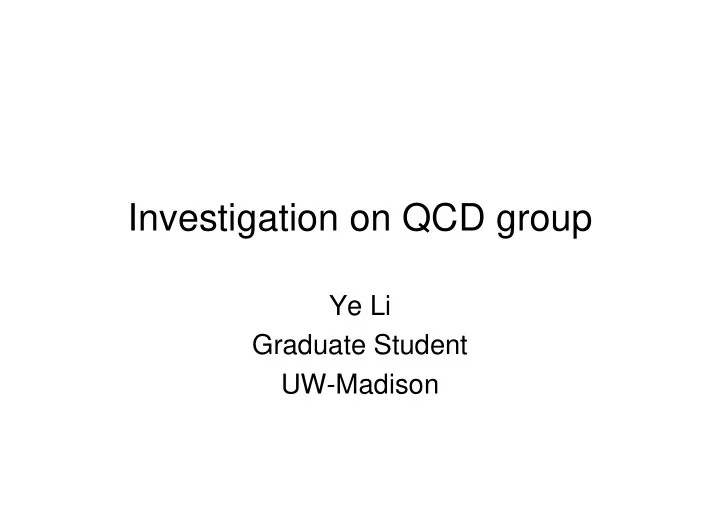

Investigation on QCD group Ye Li Graduate Student UW-Madison
Inclusive Jet Production using the Midpoint Algorithm • Measurement of inclusive jet cross section • 5 different rapidity regions • Up to |Y|=2.1 • Based on 1 fb -1 CDF data • Potentially important to new physics such as quark structure (Tevatron ~ 10 -19 m) • Useful to constrain (anti)proton PDF
• Jet algorithm: Associate clusters of these particles into jets such that the kinematic properties of the jets can be related to the corresponding properties of the energetic partons produced in the hard scattering process. • 4 general criteria: – Fully specified – Theoretically well-behaved – Detector Independence – Order Independence
• Cross Section in the 5 rapidity bins:
• Ratio to CTEQ6.1M for the 5 rapidity bins
• Conclusion: Agreed well with the pQCD prediction of the NLO program EKS using CTEQ6.1M parton distribution
b-bbar Dijet Production using SVT • Based on about 260 pb -1 • Reconstructed using a cone algorithm • Data is selected requiring two displaced tracks at Level 2 • cross section is measured in the central region (|Y|< 1.2)
• Jets are tagged using the 2 dimensional SecVtx algorithm: – the secondary vertex inside the jet is reconstructed and the jet is positively tagged if the distance of the secondary vertex to the primary vertex of the interaction is positive with respect to the jet axis.
• The main requirements that define the "SVT b-tagged" jet: – Jet tagged by SecVtx algorithm with E T >30 GeV and |Y|<1.2 – Jet associated to a SVT track with P T >2 GeV and |d0|>120 μ m
• b-bbar purity for 2 SVT b-tagged jets is quite high:
• Result: – The differential cross section unfolded to the hadron level is shown in the pictures attached. – The measurement is compared to LO MC and to NLO predictions from MC@NLO. – The MC@NLO sample is generated using a minimum quark P T of 10 GeV in |Y|<1.75, CTEQ6.1M PDFs, μ R = μ F = sqrt(P T 2 + m 2 ), , and Jimmy to simulate multiple parton interactions.
• The full jet Et range
• Differential cross section as a function of the leading jet E T
• Differential cross section as a function of the di-jet invariant mass
• Differential cross section as a function of the di-jet azymuth distance
•Thanks!
Recommend
More recommend